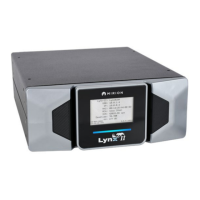Hardware
Lynx II DSA User's Manual – 7096089 111
Note: While the Auto Pole/zero procedure is operating, the Start/Stop acquisition
controls are disabled. While the acquisition is in progress, the Start button for the
“Auto Pole Zero” is disabled.
An automatic pole/zero procedure is initiated by pressing the Start button. If the Start
button is 'grayed out', the acquisition may be in progress. The automatic pole/zero
procedure will begin when the Start button is pressed; the status will be reported as “In
progress”. The Auto P/Z procedure will continue until either conversion is achieved, or,
the three-minute timeout expires, or the Stop button is pressed; the reported “Auto Pole
Zero” Status will be updated accordingly.
If the timeout is reached, the hardware will be restored to the original Pole/zero setting
when the Auto P/Z procedure was started. The status will report as “Off, Timed Out”.
Status with “Input rate too low” or “Input rate too high” indicates that the event data does
not meet the rate or amplitude requirements. If stopped prematurely the status will report
as “Off, Aborted”.
Timeouts may be due to incorrect count rate, improper signal amplitude, incompatible
time constant from the preamplifier/detector, or a poor quality signal (example: significant
periodic noise or secondary time constants) from the preamplifier/detector. You may wish
to monitor the filter output with the oscilloscope for further investigation into the cause of
a failed result.
If the automatic pole/zero completes successfully the hardware will be updated with the
new Pole/Zero setting; the status will report back as “Done, Complete”. The Auto Pole
Zero Value will display the new pole/zero setting.
LT Trim
Allows adjustment of the trapezoid pulse evolution time or 'dead time' to optimize live
time correction (LTC) performance. The adjustment range is 0 to 1000; the default value
of 500 provides good LTC performance for a wide range of applications. Please refer to
Live Time Correction With a Live Source for additional details on optimizing the LT Trim
setting.
Overload Recovery Extension Time
Time in microseconds is added to the default overload recovery when a cosmic event
overloads the preamplifier. The default recovery time in the Lynx II is approximately 2.5x
the shaping time (Rise + Flat Top). The value specified through the Overload Recovery
Extension Time ranges from 0 microseconds to 6,550 microseconds in steps of 10
microseconds.
Low Energy Applications
For some low energy applications, even the manual LLD cutoff may still prevent the
recording of very low energy events. For this purpose, in addition to the Manual LLD
Mode and LLD(%) setting, the Lynx II exposes additional parameters in the Digital Filter
settings that extend the flexibility for low energy applications.
Low energy events can easily be captured by setting the Slow Discriminator Mode to
Manual and lowering the Manual Slow Disc (%) threshold towards 0.0% until either the
desired operation is achieved, or the noise level is reached.

